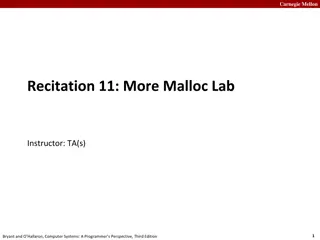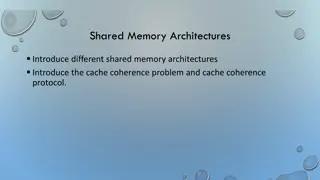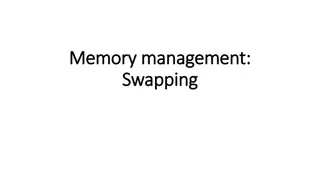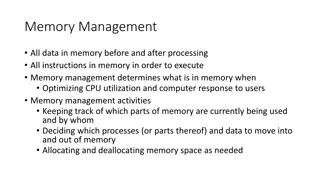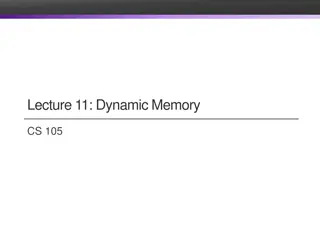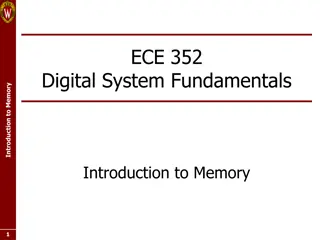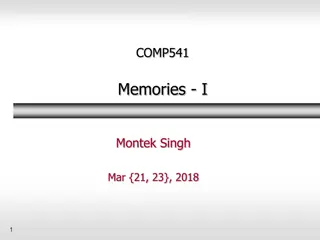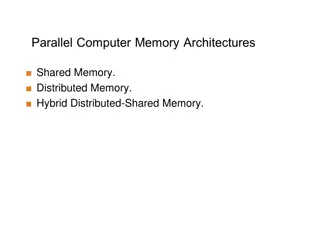Memory Ordering in Programming
Memory ordering in programming is crucial for developers to understand, as it dictates the sequence of memory operations at different levels - source code, program order, and execution order. Compiler optimizations and reordering of memory accesses can impact how code is executed by the processor, even if the source code order is preserved. Awareness of these concepts is key for writing efficient and correct software.
Download Presentation

Please find below an Image/Link to download the presentation.
The content on the website is provided AS IS for your information and personal use only. It may not be sold, licensed, or shared on other websites without obtaining consent from the author.If you encounter any issues during the download, it is possible that the publisher has removed the file from their server.
You are allowed to download the files provided on this website for personal or commercial use, subject to the condition that they are used lawfully. All files are the property of their respective owners.
The content on the website is provided AS IS for your information and personal use only. It may not be sold, licensed, or shared on other websites without obtaining consent from the author.
E N D
Presentation Transcript
The Horrors of Memory Ordering CS 161: Lecture 15 3/30/2020
The Memory Operations in a Single Thread Typically, a developer writes a thread s code in a high-level language (e.g., C++, Go) and relies on the compiler to translate the source code to machine instructions The source code order of memory operations refers to the order of loads and stores at the source code level void foo(int* i, int* j, int* x, int* y, int* out) { int sum_ij = (*i) + (*j); int sum_xy = (*x) + (*y); *out = sum_ij + sum_xy; } 0 1 2 3 4
Source-code Order Is A Lie Source-code order: the sequencing of memory reads and writes specified by a developer in a single thread s code Program order: The sequence that the compiler issues Execution order: The sequence that the processor executes These orders can differ, as long as source-code-order semantics are preserved! Ex: Compiler optimizations may eliminate memory accesses //No compiler optimization: //v stored in -8(%rbp), //p stored in -24(%rbp). movq %rdi, -24(%rbp) movq $0, -8(%rbp) .L5: cmpq $9, -8(%rbp) ja .L4 //Exit the loop movq -24(%rbp), %rax movq (%rax), %rax addq %rax, -8(%rbp) jmp .L5 jbe .L2 //-O2 optimization: The value pointed //to by p is moved into a register, and //local variable v stays in a register! movq (%rdi), %rdx xorl %eax, %eax .L2: addq %rdx, %rax cmpq $9, %rax uint64_t foo(uint64_t* p){ uint64_t v = 0; while (v < 10) { v += *p; //Memory access! } return v; }
Source-code Order Is A Lie Source-code order: the sequencing of memory reads and writes specified by a developer in a single thread s code Program order: The sequence that the compiler issues Execution order: The sequence that the processor executes These orders can differ, as long as source-code-order semantics are preserved! Ex: Compiler may reorder accesses //No compiler optimizations: four //memory operations (two reads and //two writes). movq y(%rip), %rdx movq y(%rip), %rax imulq %rdx, %rax movq %rax, x(%rip) movq $42, y(%rip) movq %rax, x(%rip) uint64_t x; uint64_t y; //-O2 optimizations: only one read //and two writes, with y written //early w.r.t. program order! movq y(%rip), %rax movq $42, y(%rip) imulq %rax, %rax void bar(){ x = y * y; y = 42; }
Source-code Order Is A Lie Source-code order: the sequencing of memory reads and writes specified by a developer in a single thread s code Program order: The sequence that the compiler issues Execution order: The sequence that the processor executes These orders can differ, as long as source-code-order semantics are preserved! Ex: Even if the compiler issues assembly instructions that respect program order, the processor may execute those instructions out of order if source-code-order data dependencies wouldn t be violated mov (%rax), %rbx add %rbx, %rcx sub %r9, %r10 Must be executed in order due to the data dependency Can be executed before, after, or between the mov+add
x86: Store Buffers, Multiple Cores, and LOCK Prefixes Each core has a FIFO (w.r.t. program order) store buffer A memory write first goes into the store buffer Asynchronously, hardware propagates the write to the downstream memory hierarchy (L* + RAM) A memory read checks the store buffer before pulling data from memory, ensuring a core reads its own writes Note that x86 execution order always issues stores in program order, since the store buffer is FIFO w.r.t. program order! mov $0x42,(%rax) //Suppose %rax=0xAA mov $0x0, (%rbx) //Suppose %rbx=0xBB mov (%rax), %r12 Store buffer (FIFO) Store buffer (FIFO) *(OxAA)=0x42 *(OxBB)=0x0 L1 i-cache L1 d-cache L1 i-cache L1 d-cache L2 cache L2 cache L3 cache RAM
x86: Store Buffers, Multiple Cores, and LOCK Prefixes Store buffers means that a write made by one core may not be immediately visible to another core! A store buffer is not a cache, so it tries to issue stores as quickly as possible (namely, as soon as the store instructions commit) However, delays can still occur! mov $0x42, (%rax) //Writes to 0xAA mov (%r12), %r10 //Reads from 0xAA Read misses in the store buffer . . . Store buffer (FIFO) Store buffer (FIFO) *(OxAA)=0x42 L1 i-cache L1 d-cache L1 i-cache L1 d-cache . . . so a stale value is pulled from L1/L2/L3/ RAM! L2 cache L2 cache L3 cache RAM
x86: Store Buffers, Multiple Cores, and LOCK Prefixes The LOCK prefix can precede instructions that perform a read-modify-write on a memory location Ex: LOCK inc 0x16(%rax) //Increment 0x16(%rax) Ex: LOCK bts (%rax), 0x2 // Bit test and set : Read //second bit of (%rax), //store it in the carry //flag, then set second //bit to 1 At the end of the LOCK d instruction, the store buffer is flushed before lock is released While a core executes a LOCK instruction, other cores can t read or write memory (and can write to but not read from the local store buffer) //...other stuff... }; struct spinlock { std::atomic_flag f; Store buffer (FIFO) void lock_noirq() { while (f.test_and_set()) { Store buffer (FIFO) LOCK prefix lock (hardware-maintained) L1 i-cache pause(); } } L1 d-cache L1 i-cache L1 d-cache L2 cache L2 cache L3 cache RAM
//Suppose lock lives at 0xBB LOCK bts (%rax), 0x2 The LOCK prefix can precede instructions that perform a read-modify-write on a memory location Ex: LOCK inc 0x16(%rax) //Increment 0x16(%rax) Ex: LOCK bts (%rax), 0x2 // Bit test and set : Read //second bit of (%rax), //store it in the carry //flag, then set second //bit to 1 At the end of the LOCK d instruction, the store buffer is flushed before lock is released While a core executes a LOCK instruction, other cores can t read or write memory (and can write to but not read from the local store buffer) LOCK bts (%rax), 0x2 //Blocked while other core has lock! //Can now do the read-modify-write //on the lock! Store buffer (FIFO) Store buffer (FIFO) *(OxBB)=0x4 LOCK prefix lock (hardware-maintained) L1 i-cache L1 d-cache L1 i-cache L1 d-cache L2 cache L2 cache L3 cache RAM
x86: Store Buffers, Multiple Cores, and LOCK Prefixes What if one set of program- order memory operations must all occur before a second set of program-order memory operations occur? All loads and stores before mfence will occur before all loads and stores after mfence mfence also flushes the store buffer (which isn t strictly necessary to satisfy the ordering requirements) Any LOCK d instruction also orders memory operations and flushes the store buffer like mfence does mov $0x42,(%rax) //Suppose %rax=0xAA mov (%rbx), %r11 //Might execute before or //concurrently w/prior instruction mfence //Write from first instruction now //visible to second core mov $0x1, (%rcx) //Can t be reordered upward //[even though doing //so would not violate //single-threaded data //dependencies!] Store buffer (FIFO) Store buffer (FIFO) *(OxAA)=0x42 LOCK prefix lock (hardware-maintained) L1 i-cache L1 d-cache L1 i-cache L1 d-cache L2 cache L2 cache L3 cache RAM
Case Study: A Correct x86 Spinlock In 1999, Linux kernel developers were trying to determine the fastest (but still correct!) way to design a spinlock for a multicore x86 system At the time, the x86 memory model was underspecified, leading to confusion //Here s a small implementation; the lock //lives at (%eax). // Free: (%eax) == 0 // Held: (%eax) == 1 acquire: LOCK bts (%eax), 0 //Read zeroth bit of //(%eax), store it //in the carry flag //CF, then set the //zeroth bit to 1 jc acquire //Spin if CF==1 //i.e., lock was held enter: //The critical section is here release: LOCK btr (%eax), 0 // Bit test+reset : //Read the zeroth bit //into CF and then set //the bit to 0
Case Study: A Correct x86 Spinlock //Here s a small implementation; the lock //lives at (%eax). // Free: (%eax) == 0 // Held: (%eax) == 1 acquire: LOCK bts (%eax), 0 //Read zeroth bit of //(%eax), store it //in the carry flag //CF, then set the //zeroth bit to 1 jc acquire //Spin if CF==1 //i.e., lock was held enter: //The critical section is here LOCK d instructions have mfence semantics So, having LOCK d instructions at the start and end of the critical section ensure that the CPU cannot reorder the critical section instructions to be outside of the lock acquire and release! release: LOCK btr (%eax), 0 // Bit test+reset : //Read the zeroth bit //into CF and then set //the bit to 0
Case Study: A Correct x86 Spinlock In 1999, Linux kernel developers were trying to determine the fastest (but still correct!) way to design a spinlock for a multicore x86 system At the time, the x86 memory model was underspecified, leading to confusion //The Linux implementation: lock lives at (%eax). // Free: (%eax) == 1 // Held: (%eax) <= 0 acquire: LOCK dec (%eax) //Atomic decrement of the lock //variable, setting the sign //flag SF to 1 if (%eax) is //now negative (i.e., < 0). jns enter //"Jump if not sign": We've //grabbed the lock if the //lock is now 0 (i.e., SF=0), //otherwise, the lock is held, //so we decremented (%eax) //to a negative value and SF=1. spin: cmp (%eax), 0 //Compare the lock to 0. jle spin //If the lock is <= 0, it's //held by someone else---spin! jmp acquire //Otherwise, the lock is free, //so try to get it. enter: //The critical section starts here
Case Study: A Correct x86 Spinlock This code exploits knowledge about the memory model of an x86 processor The LOCK prefix is to be avoided when possible, because it prevents other CPUs from issuing memory operations (hence the split between the acquire and spin phases) x86 guarantees that reads and writes to aligned 32-bit values are atomic //The Linux implementation: lock lives at (%eax). // Free: (%eax) == 1 // Held: (%eax) <= 0 acquire: LOCK dec (%eax) //Atomic decrement of the lock //variable, setting the sign //flag SF to 1 if (%eax) is //now negative (i.e., < 0). jns enter //"Jump if not sign": We've //grabbed the lock if the //lock is now 0 (i.e., SF=0), //otherwise, the lock is held, //so we decremented (%eax) //to a negative value and SF=1. spin: cmp (%eax), 0 //Compare the lock to 0. jle spin //If the lock is <= 0, it's //held by someone else---spin! jmp acquire //Otherwise, the lock is free, //so try to get it. enter: //The critical section starts here
Case Study: A Correct x86 Spinlock To implement unlock, the Linux developers were unsure a LOCK d implementation like . . . LOCK xchg 1, (%eax) . . . could be replaced by . . . mov 1, (%eax) . . . which avoids a slow_LOCK- prefixed instruction The concern was that, in a non- LOCK d approach, the CPU could reorder memory operations in the critical section to be *after* the release of the lock //The Linux implementation: lock lives at (%eax). // Free: (%eax) == 1 // Held: (%eax) <= 0 acquire: LOCK dec (%eax) //Atomic decrement of the lock //variable, setting the sign //flag SF to 1 if (%eax) is //now negative (i.e., < 0). jns enter //"Jump if not sign": We've //grabbed the lock if the //lock is now 0 (i.e., SF=0), //otherwise, the lock is held, //so we decremented (%eax) //to a negative value and SF=1. spin: cmp (%eax), 0 //Compare the lock to 0. jle spin //If the lock is <= 0, it's //held by someone else---spin! jmp acquire //Otherwise, the lock is free, //so try to get it. enter: //The critical section starts here
Case Study: A Correct x86 Spinlock To implement unlock, the Linux developers were unsure a LOCK d implementation like . . . LOCK xchg 1, (%eax) . . . could be replaced by . . . mov 1, (%eax) . . . which avoids a slow_LOCK- prefixed instruction The concern was that, in a non- LOCK d approach, the CPU could reorder memory operations in the critical section to be *after* the release of the lock //The Linux implementation: lock lives at (%eax). // Free: (%eax) == 1 // Held: (%eax) <= 0 //Imagine that we acquire the lock here using //an acquisition implementation that has mfence //semantics . . . //. . . and then execute the critical section . . . mov (%ebx), %ecx //CS1 mul %ecx, %edx //CS2: Dependency on CS1 mov %edx, 16(%ebx) //CS3: Dependency on CS2 //. . . and then release the lock like this: release: mov 1, (%eax) //Set lock to free . //Note that this instruction is not LOCK- //prefixed, so it does not implement an //mfence-style memory barrier. //CS* have no dependency on spinlock (%eax). //Could the processor reorder (say) CS3 to //*after* the lock release??? Would violate the atomicity of critical sections!
An Intel developer replied to a thread on the Linux kernel mailing list . . .
A store buffer entry for write w can only be flushed if all instructions prior to w in program order have finished (and exited the store buffer if a write)! Store buffer (FIFO) Store buffer (FIFO) *(OxAA)=0x42 LOCK prefix lock (hardware-maintained) L1 i-cache L1 d-cache L1 i-cache L1 d-cache L2 cache L2 cache L3 cache RAM
Case Study: A Correct x86 Spinlock //The Linux implementation: lock lives at (%eax). // Free: (%eax) == 1 // Held: (%eax) <= 0 //Imagine that we acquire the lock here using //an acquisition implementation that has mfence //semantics . . . //. . . and then execute the critical section . . . mov (%ebx), %ecx //CT1 mul %ecx, %edx //CT2: Dependency on CT1 mov %edx, 16(%ebx) //CT3: Dependency on CT2 This is safe: If an external CPU sees the spinlock as free (i.e., sees the write to (%eax)), then all of the prior reads and writes in the critical section have completed. //. . . and then release the lock like this: release: mov 1, (%eax)
Which Memory Operations Does x86 Reorder? Suppose that we examine two program- order memory operations: LoadLoad, StoreStore, LoadStore, StoreLoad x86 only does StoreLoad reordering! StoreStore: Two program-order memory writes execute in program order LoadStore: A memory write is never executed before a memory read that is earlier in program order LoadLoad: Two program-order memory reads will execute in program order //Won t be reordered, even //if the instructions have //no dependencies. mov 0, 8(%rax) mov 1, 12(%rbx) //Won t be reordered, even //if the instructions have //no dependencies. mov 8(%rax), %rcx mov 1, 12(%rbx)
Which Memory Operations Does x86 Reorder? Suppose that we examine two program- order memory operations: LoadLoad, StoreStore, LoadStore, StoreLoad x86 only does StoreLoad reordering! StoreStore: Two program-order memory writes execute in program order LoadStore: A memory write is never executed before a memory read that is earlier in program order LoadLoad: Two program-order memory reads will execute in program order StoreLoad: A memory read can execute before a memory write that is: 1. Earlier in program order 2. Doesn t involve the same memory location //Won t be reordered, even //if the instructions have //no dependencies. mov 8(%rax), %rbx mov 16(%rcx), %r11 //Can be reordered. mov %rax, 8(%rbx) mov 16(%rcx), %r11 //*Cannot* be reordered: //Doing so would cause the //load to not fetch the //appropriate value from //the store! mov %rax, 8(%rbx) mov 8(%rbx), %r11
Which Memory Operations Does x86 Reorder? Suppose that we examine two program- order memory operations: LoadLoad, StoreStore, LoadStore, StoreLoad x86 only does StoreLoad reordering! StoreStore: Two program-order memory writes execute in program order LoadStore: A memory write is never executed before a memory read that is earlier in program order LoadLoad: Two program-order memory reads will execute in program order StoreLoad: A memory read can execute before a memory write that is: 1. Earlier in program order 2. Doesn t involve the same memory location Motivation Writes are fast to complete because they can always go in store buffers and update L*/RAM later Reads must always pull from L*/RAM, so try to start them as soon as possible
Different CPUs Have Different Memory Models! [Ref: https://en.wikipedia.org/wiki/Memory_ordering]
IMPORTANT: Reordering Can Never Break Single-threaded Program-order Semantics! A CPU always respects single-threaded, program-order data dependencies Two instructions can only be reordered if they have no dependencies So, the CPU guarantees that, from the perspective of single-threaded program- order, all instructions perceive the results that would arise if the execution order was the program order Reordering-induced incorrectness is only possible for cross-thread synchronization invariants that the CPU can t see!
Example: AHCI Interactions AHCI interactions involve two logical threads (the kernel and the disk) Kernel code interacts with the disk via the disk s memory-mapped registers However, the compiler is totally unaware of the disk: the compiler just sees memory reads and writes in the kernel s source code So, the human developer is responsible for synchronizing activity between the kernel and the disk
The C++ compiler portably implements std::atomics using the appropriate local- ISA instructions! Every non-relaxed std::atomic operation is also a compiler barrier! //Chickadee s k-ahci.cc: Issuing an //NCQ operation. // //Tell the device about the buffer to //use for the disk read. dma_.ct[slot].buf[0].pa = ka2pa(buf); dma_.ct[slot].buf[0].maxbyte = sz - 1; dma_.ch[slot].nbuf = 1; dma_.ch[slot].buf_byte_pos = sz; CS161 student How should this be implemented using my CPU s ISA? Do I need to worry about compiler reordering?
struct spinlock{ union { std::atomic_flag f; std::atomic<unsigned char> alias; } f_; Every non-relaxed std::atomic operation is also a compiler barrier! void lock_noirq() { while (f_.f.test_and_set()) { pause(); } } bool is_locked() { return f_.alias.load(std::memory_order_relaxed) != 0; } }; Means that: The compiler must ensure that the load is atomic, but . . . The compiler and the hardware can reorder the load in any way that satisfies single-threaded data dependencies
//Chickadees k-ahci.cc: Issuing an //NCQ operation. // //Tell the device about the buffer to //use for the disk read. dma_.ct[slot].buf[0].pa = ka2pa(buf); dma_.ct[slot].buf[0].maxbyte = sz - 1; dma_.ch[slot].nbuf = 1; dma_.ch[slot].buf_byte_pos = sz; Every non-relaxed std::atomic operation is also a compiler barrier! On x86, std::atomic_thread_fence(std::memory_order_release) is a nop! x86 already provides the desired property, namely, no StoreStore or LoadStore reordering. //Configure the NCQ request. size_t first_sector = off / sectorsize; size_t nsectors = sz / sectorsize; dma_.ct[slot].cfis[0] = cfis_command | (unsigned(cmd_read_fpdma_queued) << 16) | ((nsectors & 0xFF) << 24); //...other config stuff... //Ensure all previous writes have made //it out to memory. std::atomic_thread_fence(std::memory_order_release); //Tell the drive which NCQ slot is used. pr_->ncq_active_mask = 1U << slot; //Tell the drive that a command is available. pr_->command_mask = 1U << slot; //The write to `command_mask` wakes up the device. //The disk will generate an interrupt when //the IO has completed! The fence tells the compiler to: Not reorder memory operations around the fence: a compiler barrier! Instruct the hardware that all reads and writes before the fence should execute before all post-fence writes
x86: Store Buffers, Multiple Cores, and LOCK Prefixes A recap of what we ve learned A core issues writes in FIFO program order to the local store buffer During a read, a core checks its store buffer before L*/RAM An mfence: Forces earlier program-order memory operations to complete before allowing subsequent ones to complete Flushes the store buffer A LOCK d instruction: Prevents other cores from reading/writing L*/RAM and reading from local store buffers Flushes the store buffer More generally, a store is only released from the store buffer if all prior program-order memory operations have completed Store buffer (FIFO) Store buffer (FIFO) LOCK prefix lock (hardware-maintained) L1 i-cache L1 d-cache L1 i-cache L1 d-cache L2 cache L2 cache L3 cache RAM























